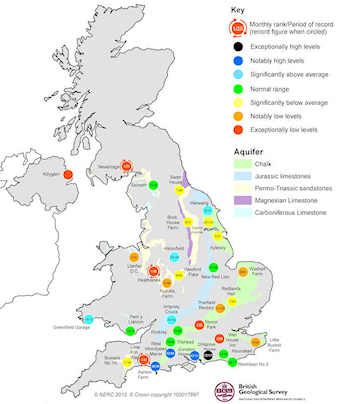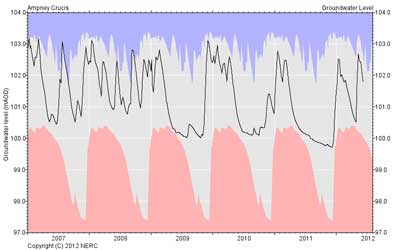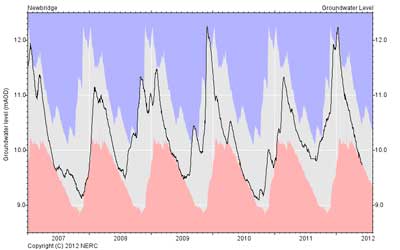The 2012 drought and groundwater levels |
The exceptional rainfall over the past 3 months has been having a surprisingly significant effect on groundwater levels, and we are expecting to see a dramatic change in the UK groundwater level map when the June Hydrological Summary is released tomorrow.
All of the hosepipe bans, which were put in place by seven water companies in the spring, have now been lifted.
Low rainfall last winter, following below average rainfall in the previous winter and spring, resulted in exceptionally low river flows and groundwater levels across much of England by the end of March 2012. The situation has been alleviated in most areas by extremely wet weather since April.
Monthly review of groundwater levels
Our monthly review of groundwater levels for May 2012 shows a mixed picture, with many groundwater levels now in the normal range for the time of year, while others are still significantly below average.
The recent rainfall was persistent enough to wet the soil overlying the outcrop areas of most of the major aquifers of England and Wales, allowing water to infiltrate. We have seen groundwater levels rise in many observation wells, particularly in aquifers that respond quickly to recharge. For example, the water level in the well at Ampney Crucis, in the Jurassic Limestone of the southern Cotswolds, rose from near minimum levels (for the time of year) at the end of March to above average by the end of April.
Groundwater levels in the Permo-Triassic sandstones are not yet rising, e.g. Newbridge hit record low levels in May.
Why are groundwater levels rising in some areas and not others?
Aquifers comprising fractured rocks such as limestones often 'fill up' quickly, causing groundwater levels to rise rapidly after rain, but the water can also flow quickly through the cracks, flowing out of the aquifer and causing groundwater levels to decline again. Water levels will respond more slowly in aquifers such as sandstones where water infiltrates slowly through the network of tiny gaps (pores) between rock grains.
What work is BGS doing on drought?
The BGS holds the National Well Record Archive which contains records of groundwater levels since the 1800s for a number of boreholes across the country.
These records enable us to look at impact of previous periods of drought on groundwater systems and to make predictions regarding the periodicity and duration of, and response to future droughts. Looking at the records we can see that, although droughts don't happen frequently, the current drought situation is a typical groundwater response to reduced recharge during two successive relatively dry winters.
We recently completed the Future Flows and Groundwater Levels project, which assessed the impact of climate change on river flows and groundwater levels across England, Wales and Scotland, using the latest probabilistic climate projections.
Long-term analysis
We are also working with partners to improve monitoring for long-term analysis of groundwater levels across the UK. This will help us to assess and understand the potential impact of long-term climate change on groundwater and surface water levels.
The BGS has an active programme of groundwater drought research in the UK and internationally.
Our sister organisation the Centre for Ecology and Hydrology holds information on surface water flows and drought.
Why is groundwater important during droughts?
Groundwater is widely used for water resources in the UK, and it becomes a critical resource during surface water droughts. Prolonged periods of dry weather lead to reduced river flows and falling reservoir levels, but groundwater levels take longer to fall.
As well as providing water for domestic, industry and agricultural use, groundwater helps to maintain ecologically important flows in many of our rivers during periods of drought. In these ways, groundwater provides the UK with resilience to droughts.
However, if we have long periods of reduced rainfall, particularly during the winter and early spring months as has occurred this year, then aquifers don't get replenished and groundwater levels can fall significantly. This can adversely affect surface water flows, groundwater dependent ecosystems and water quality.
Contact
Contact Dr John Bloomfield for further information









